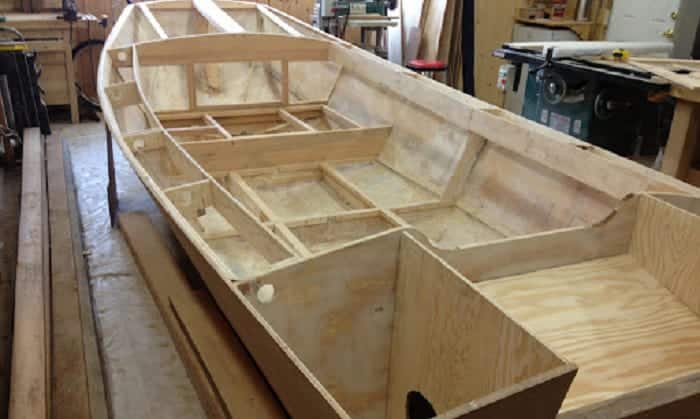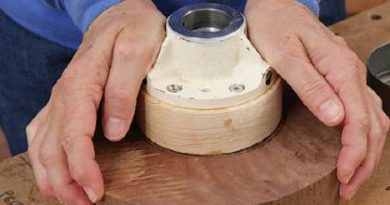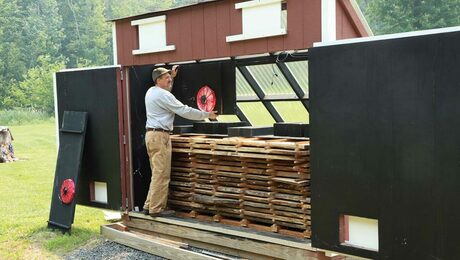Home Plywood Boat Building – Stitch and Glue or Ply on Frame?
There are two general modern techniques for building plywood boats at home: the traditional, Ply on Frame construction and the newer Stitch and Glue method. Each has its advantages and disadvantages. Both methods of boat construction are capable of producing very functional, strong, and safe vessels. Which boat construction method a potential boat builder should select, depends as much on the skills, patience, and preferences of the builder as on the desired characteristics of the finished boat.
Let’s begin by discussing the traditional ply-on-frame construction method. It’s done by starting with wooden frames, sometimes called ribs. These are usually straight-sided, however, some older designs try to incorporate curves in the rib elements, complicating the construction considerably. These frames are positioned using a construction jig, generally oriented so that the hull is built upside down.
Longitudinal frame members are attached into notched slots in the ribs. The first one is a heavy frame element called the keelson that runs down the center of the ribs. To the forward end of this element, the vertical timber that forms the prow of the boat is attached, called the stem.
Two longitudinal frame elements run along the upper edges of the hull, one on each side, called sheer clamps. Two more elements are added to the end of the ribs where the hull bottom transitions to the hull sides. This joint in the hull is called the chine and the frame member installed here is called the chine log. Depending on the size of the hull and the designer’s philosophy, sometimes, additional longitudinal members may be specified to complete the boat hull framing.
Most often each of these joints is glued and screwed or sometimes, bolted together. These days, high-strength synthetic adhesives, such as epoxy or the new polyurethane adhesives make excellent for bonded joints because unlike the older natural, casein, or polyvinyl acetate glues, the modern glues will still hold even if the joints aren’t perfectly matched. They fill gaps better.
Next, the plywood planking is leaned against the framework, cut a bit oversized, glued and nailed (or screwed in place), and trimmed to the edges of the framing. Finally, the plywood is finished off with one or more layers of fiberglass, or simply saturated in epoxy to improve strength, abrasion resistance, and water incursion.
Stitch and glue boats, on the other hand, are built in an entirely different manner. These boats are built using precisely cut panels that will end up forming the shape of the hull. There is no internal framing, or if there is, it takes the form of bulkheads rather than frame elements.
The builder uses either full-sized panel drawings supplied by the designer or lays out the finished shape of the sides and bottom of the hull on the plywood planking. The planking is then cut out. One side may be used as a pattern for the other because getting both sides precisely the same shape and keeping the bottom very symmetrical are important.
Once the panels are cut out a row of small holes is drilled into adjacent panels close to the edge and either copper wire or nylon tie-wraps are threaded through the holes to “stitch” the plywood edges together. Then an epoxy mixture thickened with silica or microspheres is puttied into the joint to make a fillet and the joint is taped over with fiberglass tape. The hull is flipped over and similar joints are made on the outside of the hull. Then, if desired, the hull is fiberglassed.
Contrary to first impressions, a stitch and glue boat, if properly designed and built, is just as strong and capable as its framed counterpart. They’re simply different philosophies in construction. Just as cars and aircraft have changed from framed and covered construction to a more modern, unibody in the case of cars, and monocoque in the case of aircraft, construction, so naval architects have been transitioning from framed to stitch and glue construction for light, strong, easy to build boats.
Now that you know how these boats are built, let’s talk about what kinds of skills and personality the builder has, to select the right kind of boat for him. First, let’s look at woodworking skills. Do you like to work with wood? Does planning on a nice piece of hardwood bring you joy? Do you like the smell, and the feel and derive satisfaction from shaping wood? Don’t laugh. This is a serious question. Some people will say, yes, that’s me. I love it! Some will say, no, not really. I see it as a means to an end and I just want to get done.
If you’re in the first group, loving to work wood, you probably have what it takes to make a framed boat. It requires woodworking and being careful about joint fits. It requires some patience and a sense of pride in your workmanship.
If you’re in the second group, you probably should build a stitch and glue boat. They go together much faster with fewer steps. They also require less woodworking knowledge and the use of tools. You still have to be able to cut out plywood fairly precisely, but almost everything can be done with simple power tools.
Building a stitch-and-glue boat is a messier proposition than a ply-on-frame hull. You have to mix and spread lots of epoxy, usually wearing rubber gloves, If you scratch your nose, you’re going to have to spend some unpleasant time with acetone getting the epoxy off too. Working with wood, you just dust yourself off most days. There are adhesives used, but not to the extent of a stitch and glue boat.
When you sand epoxy, you should wear a respirator to prevent epoxy and fiberglass dust from getting into your lungs. Sawdust isn’t as damaging to your system, but I still do wear a respirator when sanding large expanses of wood with a power sander.
Well, I hope this has helped you decide which of the two types of hulls to build. I would strongly encourage everyone to build a boat. It’s a fun hobby and a great experience. It’s also the parent and child project. I can’t imagine a better experience for a child than to learn woodworking by helping to build a boat and take it fishing.
Source by Jeff Spira




